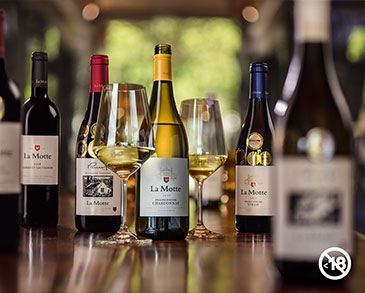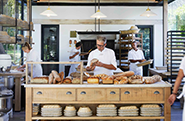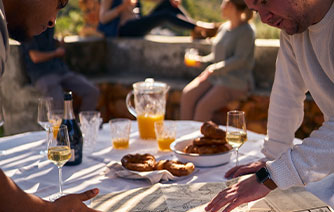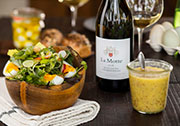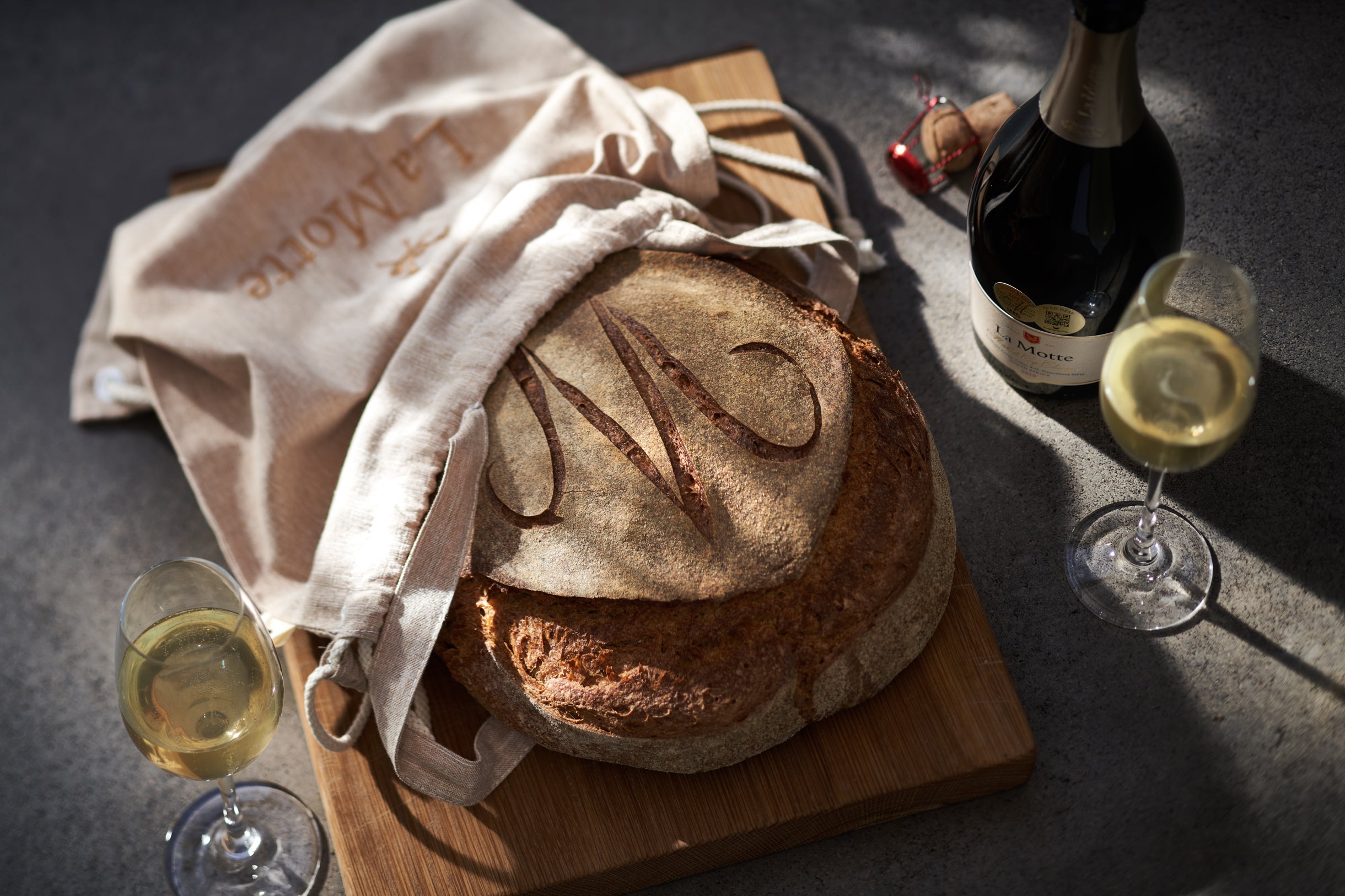
By Kit Heathcock
Fermentation has become a foodie buzz word of late: kimchi, kombucha, kefir have become part of our everyday vocabulary. But there’s so much more to this ancient art and science than a passing trend. We talk to master baker, Markus Färbinger, and La Motte cellar master, Edmund Terblanche, about the vital role fermentation plays in the bakery and in the cellar, and the fascinating alchemy that leavens bread dough, and turns sugar into the fine mousse of Cap Classique bubbles.
Sitting with Markus in the La Motte Bakery his passion for baking bubbles over like the sourdough culture behind the bakery’s deliciously crusty, chewy, flavour-packed loaves. At Ile de Pain in Knysna he earned the epithet of being the father of artisan baking in South Africa, inspiring and training a new generation of bakers. What lured him to La Motte was the chance to drill deeper into the practical lore of baking, with access to four acres set aside for growing organic wheat on the farm, and the historic watermill where they propose to mill their own wheat. It’s an adventure that has fermentation at its very core.
A yeast named saccharomyces
Cap Classique and sourdough bread owe their bubbly nature to the same family of yeasts: saccharomyces cerevisiae, to give it the full name. Within that family are thousands of different strains. “In winemaking there are more than 200 commercial strains to choose from - different yeasts each with different characteristics,” says Edmund Terblanche, who has been cellarmaster at La Motte for over 20 years. “They’re also found wild in the vineyard. So, you can bring in grapes, and just leave them and they will ferment… that’s how they made wine 6,000 years ago.” Nowadays part of the skill of a winemaker lies in choosing the right yeast strain for the wine you want to make, he says.
In artisan bread-making the sourdough culture is more complex, Markus says. “In a sourdough, there isn't just one yeast. You may have four or five yeast strains, which add character and complexity, as well as several strains of lactic acid bacteria, which play just as an important role.”
The basic fermentation process in both wine and bread is the same: yeasts feed on the sugar and carbohydrates present in the flour or grapes, and turn them into CO2 and alcohol, so far so simple. Where it gets interesting (and different between bread and wine) is in what happens along the way.
Turning a grain into a superfood
Fermentation is the original way of leavening bread. “Many thousands of years ago they would have soaked grains in water so it’s easier to eat, maybe leach out some nutrients. Think of it as an ancient muesli,” says Markus. “Then they started heating it to improve the exposure of nutrients and make it more palatable. Maybe a brew was left over on a hot summer day and they realised that it was bubbling.” The resulting nutritious leavened bread was a holistic food that was the staple of many ancient civilisations for millennia – for example, bread is what helped build the pyramids in Egypt, he says. “Fermentation is the key for deactivating anti-nutrients and thereby unlocking all the nutrients, making them bio-available. And the beautiful thing about nature, it unlocks nutrients, flavour, texture and even the ability to keep - something we have stopped talking about.”
Modern commercial breadmaking uses a single yeast strain designed solely to leaven bread fast and efficiently, Markus continues. What it doesn’t do is break down proteins (such as gluten) in the way fermentation has been doing for centuries. Or supply us with healthy bacteria that support our gut microbiome. Hence the rise of gluten intolerance, leaky gut syndrome, bloating and other digestive disorders.
“In fermentation, besides yeasts producing CO2 to make the bread rise, proteins break down into amino acids, which are essential. The body cannot produce them, we need to ingest them. Here again, these breads look like the perfect food. We’re using everything. Well fermented bread has long-chain carbohydrates, the kind runners (and diabetics) want for long slow-release energy. The short-chain sugars are consumed by the yeast. With fermentation the body gets a highly nutritive substance that is easily absorbed.”
And lactic acid bacteria (the ones present in live yoghurt) play a vital role too: they add flavour, create an acidity that allows various essential enzymes to thrive and release nutrients. They also function as a natural preservative, splitting carbohydrates to retain moisture and extending the natural shelf life of the bread. Markus says, “I don’t mean that bread stays soft for fourteen days, but in fourteen days when I slice that bread and pop it in the toaster, it smells beautiful, it feels beautiful. It’s slightly denser than on the first day, but still incredible.”
Alcohol is a by-product of fermentation that barely gets a mention on the bread-making side (it evaporates during baking). Whereas when you start talking wine-making, it’s pretty much the whole point…
Turning a grape into a bubbly with aging potential
“The fermentation bring us joy!” jokes Edmund when asked about its role in wine-making. “It breaks up the sugar in the grapes into heat, CO2 and alcohol, and you create a stable product that can last for years.” In most winemaking the CO2 is an unwanted by-product, but in Cap Classique the CO2 is captured in fine bubbles formed in the second fermentation. It’s the second fermentation that gives Champagne and Cap Classique those signature yeasty notes reminiscent of baking (brioche, biscuit, toast are descriptors that often appear in tasting notes), notes that can deepen with aging into an almost marmite savouriness. But the yeasts have to work pretty hard before they give up their flavour.
Getting yeasts fighting fit
“Wine is a fairly hostile environment for a yeast cell to do its job,” says Edmund. “A yeast cell wants to function at a pH of around 5.5, and the pH of wine is 3 to 4. Then they prefer a temperature of around 20 °C, whereas white wine is normally fermented at 12 - 16 °C. And in Cap Classique it’s also under pressure in its second fermentation. So, you have to select a yeast that has hairs on its chest to do the job.” Even then it needs some preparation, as winemaker Edwin Grace explains, “The base wine already has alcohol in it, so we can’t just add yeast to it, the yeast will die. It’s like throwing a guy with no fighting experience into a ring with Muhammed Ali, he will not make it. So, we have to toughen it up a little bit.” They prepare a culture with the yeast and over four days, each morning and evening, gradually add alcohol and sugar to it, to get it used to the conditions it will be working in, until it’s a fighting fit yeast bomb. The yeast bomb and sugar to feed it are then added to the base wine, which is then immediately bottled and sealed with a crown cap to start working its fermentation magic.
The culture for bread
The sourdough culture in bread-making also has to be fighting fit. (Markus prefers to call it a culture rather than a motherdough, starter, or other alternative and less accurate terms). Head baker, Ricardo Slawers, continues to work with the same culture he’s been using at La Motte for over 9 years, and with Markus’ input has been strengthening it with meticulous feeding and maintenance. “There are very specific ratios of feeding. It demands commitment, skill and knowledge. If you take a day off, the first day’s bread won’t be as good as the second and third days’ bread,” Markus says.
And each culture develops its own individual character, he adds. “The culture (with its mixture of yeasts and lactic acid bacteria) adjusts to the type of hydration (water added), type of grain used and its environment, making it unique to its specific place in the world.
Fermenting flavour
Fermentation is a science, but it’s also an art that the artisan baker can harness to create different flavours, textures, colours and crumb in their loaves. “We have temperature playing a role, times of fermentation, types of flour...,” says Markus. “A darker flour will create a more acidic dough by nature, a lighter flour, more delicate acidity. Longer fermentation makes a more robust flavour; shorter (but not too short) a more elegant flavour. So, when I make a baguette with sourdough, I use a very different method than if I make a dark rye bread. Fermentation is a steering mechanism of flavour.”
Flavour on the lees
Back with Cap Classique again, it’s the aftermath of fermentation that is the secret of the flavour. Once the yeast has consumed all the available sugar and formed the bubbles there’s nothing left for it to live on. “As the yeast dies it settles on the bottom, where enzymes break up the cell walls, releasing proteins and amino acids, a process called autolysis,” Edwin says. “Those proteins and amino acids are what give those yeasty notes - the baked bread or brioche flavours. The longer we leave it on the lees the more autolysis takes place releasing those flavours and adding complexity.”
Slowly does it
In both bread and wine fermentation time is of the essence – the more time the better. “Modern commercial bread-making is all about efficiency, we want it fast. The only function of modern yeast is to leaven bread in two hours start to finish,” says Markus. “Our bread takes a minimum of 18 hours in fermentation, and up to 36 hours (in my opinion you’re achieving nothing more if you go to 48 hours).” And even the mixing process takes its time. “We mix super slow in stages. First, we soak the water and flour for up to two hours, to eliminate much of the mechanical mixing. We mix for 2 minutes, let it sit for half an hour, then mix slowly for 15 minutes.” He’s brought back an old-fashioned style of mixer that is much more gentle (and slow) than the modern spiral mixer. “The more you mix the more you oxidise the flour. Taking time, mixing very gently, you retain flavour, colour and nutrients at a very high level.”
And excellent Cap Classique can’t be hurried either. “The slower we do the second fermentation the finer the bubbles,” says Edwin. “A normal wine takes 14 days and fermentation is finished. In Cap Classique, because of the alcohol already present, the second fermentation takes about 3 months to convert sugar to alcohol and gas. We want it as cold as possible but not so cold the yeast dies, that’s why we do it in winter. The cooler it is the more dissolved the bubbles are.” And then there’s no rushing the time spent on the lees. La Motte Cap Classique spends a minimum of 3 years in the bottle on the lees, absorbing all those yeasty flavours before being disgorged. The sparkling wine then can be aged further in the bottle too, having the flavours deepening over time.
Fermentation, thoughtfully grown ingredients, immense skill and care, and generous amounts of time are the essential elements that connect artisan bread and Cap Classique at La Motte.
The Bake
The flavours developed from well grown grains and flours, and a thorough mixing and fermentation schedule, are held in the cell walls of each bubble in the final rise as the loaves are loaded into the wood fired oven, yielding a golden to dark brown crust with a carbon edge - pure magic.
The (silent) popping of the cork and the (loud) cutting into the crusty loaf finally reveal the fruits of the cellar master’s skills and the master baker’s craft. The bubbles, in the thousands - seen and too small to see - release flavour, taste and texture. The celebration of flavour begins.

